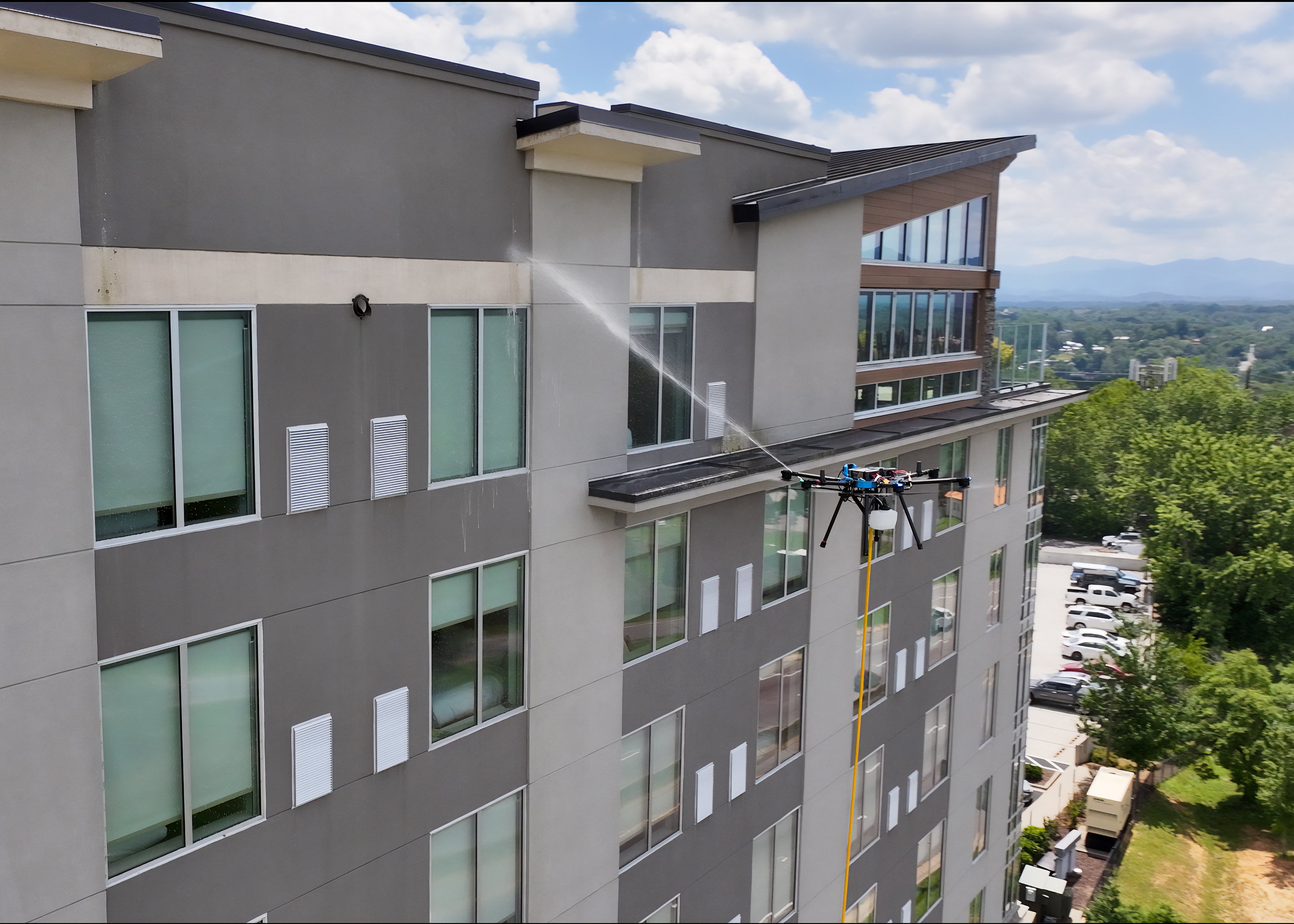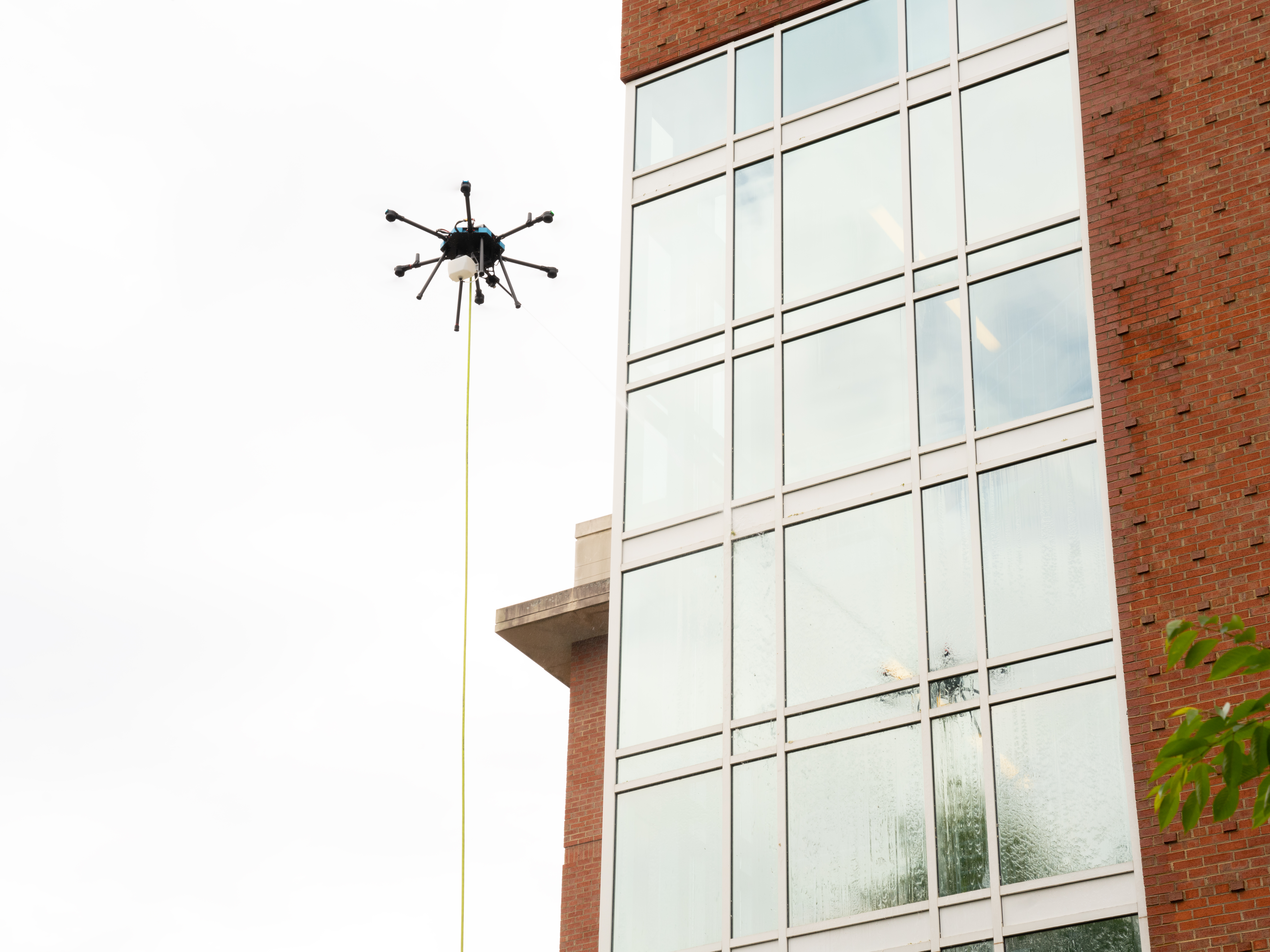Competitive Edge in Cleaning: Rethinking Pressure Washing Prices
In the dynamic world of exterior cleaning, pressure and power washing services have long stood as a go-to solution for homeowners and commercial...
4 min read
Lucid Bots : Nov 15, 2023 9:55:40 AM

Power washing has been a popular method for cleaning exterior surfaces for a long time. Power washing involves utilizing pressurized water to remove dirt, grime, and mold, and is considered “harder” on the cleaning surfaces.
However, in recent years, drones have emerged as a game-changing technology in the cleaning industry and with their rise, have introduced the concept of soft washing. These unmanned aerial vehicles (UAVs) are equipped with specialized equipment, enabling them to efficiently and effectively clean surfaces from above.
It’s already been proven that drones provide eco-friendly benefits with agricultural drones saving 44 liters of water per hectare. These advantages extend into the drones for soft washing also.
In this article, we will dive deep into the groundbreaking integration of soft washing drones and how they surpass the traditional power washing methods in various ways.
Power washing is also often referred to as pressure washing and uses hot or cold water with high cleaning power (measured in GPM) to remove dirt, grime, and other stubborn contaminants from exterior surfaces. This includes both electric pressure washers and gas pressure washer operations.
Power washing is often used in both residential and corporate settings. You can use this technique to clean driveways, sidewalks, decks, fences, and building exteriors. A specialized power washer often has a heavy duty build and expels the pressurized water through an x-jet or turbo nozzle, providing a forceful stream for effective cleaning.
However, traditional power washing comes with certain drawbacks:
According to the U.S. Consumer Product Safety Commission (CPSC), pressure washers also expel carbon monoxide that can be hazardous to breathe. They also go beyond the simple abilities of a garden hose. Pressure washers hose reels or operators of hot water pressure washers run the risk of injuries related to lacerations, bruises, and eye injuries.
Drones have transformed the commercial pressure washer landscape by providing a cutting-edge solution to tackle cleaning jobs from above.
Thanks to the attachable spray guns and mobility of drones, they can effectively disperse water and cleaning solutions for various kinds of cleaning operations. With advanced technology and remote control capabilities, operators can also precisely target and clean specific spots, ensuring a thorough and efficient cleaning process.
Additionally, the use of drones in power washing tasks reduces the safety risk for manual operators while boosting the overall effectiveness of the cleaning operation.
Where traditional power washing falls short, soft washing with drones comes in. The limitations of power washing have paved the way for drone soft washing, an alternative that offers more safety, precision, and efficiency in cleaning hard-to-reach surfaces.
Unlike the forceful high-pressure streams used in power washing, soft washing uses a low-pressure approach that is gentle on the surfaces being targeted. This means less damage to the surface and the task being easier on the cleaning operator.
The combination of the environmentally-friendly cleaning solutions together with a controlled water flow makes soft washing an effective alternative for removing dirt, algae, and other contaminants without causing any damage, especially where fragile or delicate surfaces are concerned.
This gentler approach is particularly beneficial for materials like stucco, wood, painted and stainless steel surfaces, and roofing materials, which can be easily damaged by the intense pressure of both hot and cold water pressure washers.
One of the main challenges you’ll face with traditional power washing is the inability to access high or trickier locations. Drones, on the other hand, can effortlessly navigate through tight spaces, elevated surfaces, and complex architectural features. This leads to a more comprehensive and uniform cleaning process.
With their nimble maneuverability and remote control capabilities, drones can fly to areas that would otherwise be challenging or unsafe for human cleaners to reach. This includes rooftops, upper floors of tall buildings, chimneys, gutters, and other elevated structures.
What does this mean for pressure washing businesses? A lot of time and labor saved but also eliminating the need for scaffolding or ladders, further making safety a priority during cleaning projects.
Drones come with advanced technology and more precision control that human operators cannot provide. This means you get a more systematic and streamlined approach to cleaning, allowing you to fulfill your customers’ needs faster and better.
Drones have agile flight capabilities and targeted sprayers which can cover larger areas in a shorter time, significantly reducing the cleaning duration. Additionally, the ability to navigate complex structures efficiently means that the target cleaning surfaces can be cleaned in a single pass, cutting down time spent on frustrating repetitive cleaning attempts.
Drones are also environmentally-friendly, minimizing water wastage by using precisely measured amounts of water and cleaning solutions for each surface. Unlike power washing, which can lead to excessive water runoff and consumption, drones apply a controlled and directed flow of water.
One of the biggest concerns with power washing is the need to elevate workers to high levels in order to do the work. There is also an inherent danger of high pressure hose water streams causing injuries to the operators or bystanders, especially if proper safety precautions are not followed.
To combat this, drone soft washing eliminates the need for individuals to be in close proximity to the cleaning area. Operators can control the drone remotely from a safe distance, ensuring a secure and controlled cleaning process.
With the drone doing the hard work for you, you also eliminate the risk of damage to the operator and the property, as there is no direct physical contact with the surfaces being cleaned.
Additionally, drones use a gentle and controlled water flow which can preserve the integrity of delicate materials. You can also pair specific detergents and friendly surface cleaners that prevent any potential property damage.
By prioritizing the safety of both the customers and the operators through remote operation, drone soft washing is a much safer and more reliable option for exterior cleaning tasks, providing peace of mind for everyone involved.
There’s no room for doubt that drones are a groundbreaking technology currently transforming the way the cleaning industry operates. From its gentle and efficient cleaning approach to its enhanced accessibility and improved safety, drone soft washing outshines traditional power washing in every aspect.
If you're ready to experience the ultimate solution for washing all surfaces, say goodbye to the pressure washer. It’s time to check out the Sherpa Drone.
The Sherpa Drone is a cutting-edge drone that combines state-of-the-art technology and precision control to achieve outstanding cleaning results for its users. It comes with a one-year warranty, ensuring you get the chance to unlock a whole new level of efficiency, effectiveness, and eco-friendliness.
So what are you waiting for? It’s time to get ahead of the competition by making drones your new best friend for your cleaning projects!
Don't miss out on this incredible opportunity and if you have any questions, you can always reach out to our team.

In the dynamic world of exterior cleaning, pressure and power washing services have long stood as a go-to solution for homeowners and commercial...

Commercial buildings are central to the urban landscape, reflecting the identity of businesses and brands. Maintaining the aesthetic appeal and...

Are you playing around with the idea of starting your own professional window cleaning service? Perhaps you’re looking for equipment for your future...